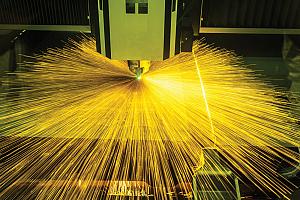Kennametal’s KOR 5 end mill enables higher feed rates for roughing - helical carbide end mills
In some cases, such as when a part having complex profiles and slots is produced from a solid material, HSM provides productive, low-load roughing by trochoidal milling. Using this technique, machinists employ a rapidly rotating milling cutter that moves along a complicated trajectory, removing thin but wide layers of material. This results in shaping the part very close to its final form.
Successful HSM relies on a key element chain comprising a machine tool, an effective machining strategy, proper toolholding, and a cutting tool.
In die- and mouldmaking, using HSM as a means of reducing production time has brought a real alternative to traditional production methods. In the aerospace industry, machining difficult-to-cut, heat-resisting superalloys using ceramic tools at high cutting speeds is now common. As for manufacturing aluminum components using HSM? These operations have become a daily reality.
KY4300 inserts are composed of aluminum oxide reinforced with silicon carbide whiskers. These whiskers have high mechanical strength and act like reinforcing steel bars in concrete, improving the strength and fracture toughness of the cutting insert.
Fig 2. Solid ceramic end mills enable cutting speeds of up to 3,280 SFM. These new end mills have a diameter range of 0.236 to 0.787 in. and are designed with three or seven flutes.
Manufacturing advances, especially in producing workpieces that are preformed, partially finished products, place a special emphasis on accurate HSM. Precise casting, metal injection moulding, and 3D printing result in workpieces that are very close to the final shape of a part, and as a result, the need to remove a high volume of material by means of rough cutting decreases.
Ceramic inserts can run at high speeds, so they reduce machining times. They resist oxidation and maintain hardness at elevated temperature, and are ideal for hard machining carbon steels, alloy steels, tool steels and cast irons.
CBN is the hardest known substance next to diamond, and provides the cutting edge for long-lasting tools that proficiently machine hard steels to 66Rc, as well as hard castings, Inconel, Monel and Stellite.

In HSM, well-directed coolant significantly enhances performance. For deep pockets and cavities, chucks with precise coolant flow results can help prevent recutting, thereby improving chip evacuation and increasing tool life.
ISCAR's New Products 2024 NEW Head with 3 Effective Cutting Edges for Boring and Enlarging Hole Sizes

About three years ago, Seco Tools Inc. (www.secotools.com) metallurgists hypothesized that if they could directly deposit the alpha form in the beginning, they could avoid the cracking issue and produce a more homogenous and tougher structure. Eliminating cracks would also make the coating a more effective thermal barrier, reducing the amount of heat getting to the substrate.
Multiflute, solid-carbide end mills were developed especially for vibration-free HSM operations. Designs featuring a varying helix angle, variable tooth pitch, and a specially shaped chip gullet are suitable for applications such as semifinish and finish HSM, as well as roughing by a trochoidal technique.
Milling difficult-to-cut HTSAs using carbide tools requires that low cutting speeds (typically 65 to 130 surface feet per minute [SFM]) be used. HSM with a small radial engagement, when the width of cut is up to 10 per cent of the tool’s diameter, usually requires cutting speeds of 230 to 265 SFM.

Accurate HSM requires that strict, repeatable tolerances be maintained during cutting operations. The level of necessary “strictness,” however, depends on the machining method (milling, turning, or drilling) and the type of operation (roughing, semifinishing, or finishing).
Easily access valuable industry resources now with full access to the digital edition of Canadian Fabricating & Welding.
PCD is a matrix of randomly arranged diamond crystals that are bonded to form an extremely hard film or wafer.
The tools are pre-engineered and precision manufactured for optimum performance for cutting challenging cutting applications. The PCD shaped cutting edges are affixed to carbide shanks by a sophisticated microwavebrazing technique that forms bonds that are able to withstand temperatures to 1,100° F.
Highly accurate HSM is necessary for removing small amounts of material. Machining operations that remove a low amount of stock per pass have distinct advantages, such as lower power consumption, less heat generation, and better surface finish.
When developing aluminum oxide (Al2O3) coating materials, it is preferable to use the alpha form of for most applications. Unfortunately, it is much easier to deposit the kappa form. Consequently, producers have deposited the kappa form and then heat-treated it in a coating furnace to transform it to alpha. However, this heating process results in an unavoidable contraction in volume, resulting in the formation of cracks in the coating.
A variety of tool bodies, heads, extensions, and reducers are available. These can reduce the need for special tools. Also, replacing a worn head does not require additional tool measuring or CNC program adjustment; the insert can be replaced without withdrawing the tool from a machine spindle.
When it comes to machining hard, difficult-to-machine materials, it’s tough to beat poly-crystalline diamond (PCD), cubic boron nitride (CBN) or ceramic inserts.
Long-reach HSM operations are particularly tricky because they require tools with long overall length. A solid tool concept usually is not economical. However, an assembled cutter comprising a body carrying a carbide cutting head is a system that can make economic sense.
When machining Inconel 718, for example, the company said speeds can be increased four to five times compared with cutting speeds when using carbide inserts. The inserts are equally productive in the automotive industry, machining alloyed gray cast-iron brake disks, and in the roll products segment removing casting crust or heavily worn rolling surfaces.
Changing technologies require new machining concepts that are more productive, more economical, and more sustainable. HSM, which already has proven itself as a method that meets today’s industrial needs, is a definite trend that no doubt, should be considered.
HSM is impossible to perform without using reliable, balanced, and accurate toolholders, and thermal shrink chucks are one of the most popular types for use in HSM.
These tools effectively machine highly abrasive, non-ferrous materials, including graphite, highsilicon aluminum alloys, fiberreinforced synthetics and copper alloys.
Emuge Corp. (www.emuge.com) has announced the expansion of its hard milling end mill line to include new PCD and CBN end mills.
Easily access valuable industry resources now with full access to the digital edition of Canadian Metalworking.
The metalworking industry first adopted high-speed machining (HSM) in the 1990s, which then required numerous changes in tooling technology and machine tool engineering. More recently there has been significant interest in HSM that is more accurate.
A resolution may be found in using ceramics as a tool material. Solid ceramic end mills can produce cutting speeds of up to 3,280 SFM. Using ceramic end mills in rough milling operations also has proved to decrease machining time and enable fast preshaping of a part for further finishing operations.
Keep up to date with the latest news, events, and technology for all things metal from our pair of monthly magazines written specifically for Canadian manufacturers!
The company said the end mills are extremely durable and can provide 50 times more tool life than conventional carbide end mills. Emuge PCD and CBN end mills are available from stock, in ball nose, torus and flat-end designs, in sizes from 0.1857 in. to 0.500 in. and in metric sizes from 4 mm to 12 mm.
New tools for HSM even integrate chip-splitting grooves in the end mill’s design. The grooves increase vibration resistance and reduce cutting forces, which improves trochoidal milling and machining performance at high overhangs. In trochoidal milling, the produced chips are thin but wide. Splitting these chips into narrower segments contributes to better chip evacuation and surface finish, which increase accuracy and effectiveness in rough HSM.
The metalworking industry is always seeking ways to increase productivity when manufacturing parts from high-temperature superalloys (HTSAs), and low cutting speed is one of the existing barriers to this goal.
Salah Taoufik, Kennametal’s global product manager for turning, said KY4300 tools have excellent high-temperature strength and hardness, and speeds can be increased 10 percent to 20 percent in most applications, compared with other ceramic grades, and produce results that include better surface finishes at lower cutting forces.
Andrei Petrilin is technical manager for Iscar Tools, 2100 Bristol Circle, Oakville, Ont. L6H 5R3, 905-829-9000, www.iscar.ca.




 18581906093
18581906093